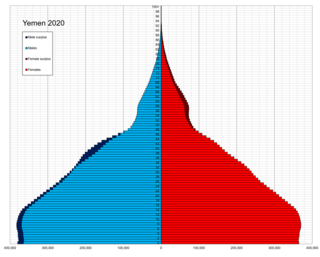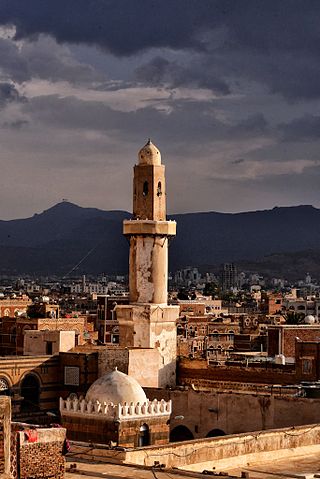Shia Islam is the second-largest branch of Islam. It holds that the Islamic prophet Muhammad designated ʿAlī ibn Abī Ṭālib as his successor (khalīfa) and the Imam after him, most notably at the event of Ghadir Khumm, but was prevented from succeeding Muhammad as the leader of the Muslims as a result of the choice made by some of Muhammad's other companions (ṣaḥāba) at Saqifah. This view primarily contrasts with that of Sunnī Islam, whose adherents believe that Muhammad did not appoint a successor before his death and consider Abū Bakr, who was appointed caliph by a group of Muhammad's other companions at Saqifah, to be the first rightful (rāshidūn) caliph after Muhammad. Adherents of Shīʿa Islam are called Shia Muslims.

The history of Yemen describes the cultures, events, and peoples of what is one of the oldest centers of civilization in the Near East. Its relatively fertile land and adequate rainfall in a moister climate helped sustain a stable population, a feature recognized by the ancient Greek geographer Ptolemy, who described Yemen as Eudaimon Arabia meaning "fortunate Arabia" or "Happy Arabia". Yemenis had developed the South Arabian alphabet by the 12th to 8th centuries BC, which explains why most historians date all of the ancient Yemeni kingdoms to that era.

Demographic features of the population of Yemen include population density, ethnicity, education level, health of the populace, economic status, religious affiliations and other aspects of the population.

The Yemeni Armed Forces are the military forces of the Republic of Yemen. They include the Yemeni Army, Yemeni Navy and the Yemeni Air Force. The capital of the country, Sana’a is where the military is headquartered. Per the constitution of Yemen, the President of Yemen serves as the commander-in-chief.

Yemen, officially the Republic of Yemen, is a sovereign state in West Asia. Located in the southern Arabian Peninsula, it borders Saudi Arabia to the north, Oman to the northeast, and the Indian Ocean to the south, sharing maritime borders with Eritrea, Djibouti and Somalia across the Horn of Africa. Covering roughly 528,000 square kilometres, with a coastline of approximately 2,000 kilometres, Yemen is the second largest country on the Arabian Peninsula. Sanaa is its constitutional capital and largest city. Yemen's estimated population is 34.7 million, comprised mostly of Arab Muslims. It is a member of the Arab League, the United Nations, the Non-Aligned Movement and the Organisation of Islamic Cooperation.
Sectarianism is a debated concept. Some scholars and journalists define it as pre-existing fixed communal categories in society, and use it to explain political, cultural, or religious conflicts between groups. Others conceive of sectarianism as a set of social practices where daily life is organised on the basis of communal norms and rules that individuals strategically use and transcend. This definition highlights the co-constitutive aspect of sectarianism and people’s agency, as opposed to understanding sectarianism as being fixed and incompatible communal boundaries.

Zaydism is one of the three main branches of Shia Islam that emerged in the eighth century following Zayd ibn Ali‘s unsuccessful rebellion against the Umayyad Caliphate. Zaydism is typically considered to be a branch of Shia Islam that comes closest to the Sunni, although the "classical" form of Zaydism over the centuries had changed its posture with regard to Sunni and Shia traditions multiple times, to the point where interpretation of Zaydi as Shia is often based on just their acceptance of Ali as a rightful successor to Muhammad. Zaydis regard rationalism as more important than Quranic literalism and in the past were quite tolerant towards Sunni Shafiism, a religion of about half of the Yemenis.
Islam entered Iran with the Muslim conquest (637–651) and led to the end of the Sasanian Empire and the eventual decline of the Zoroastrian religion in Iran (Persia). Since its establishment after the 7th-century conquest, Islam has remained the state religion of Iran except for during a short period after the Mongol invasions and subsequent establishment of the Ilkhanate in the 13th century. Following the Muslim conquest, there was a slow but steady movement of the population toward Islam, despite notable resistance, with nobility and city-dwellers being the first to convert, and the peasantry and the dehqans, or land-owning magnates slower to do so. By the 10th century, the majority of Persians had become Muslims.

Islam came to Yemen around 630 during Muhammad's lifetime and the rule of the Persian governor Badhan. Thereafter, Yemen was ruled as part of Arab-Islamic caliphates, and became a province in the Islamic empire.
Islam is historically divided into two major sects, Sunni and Shia Islam, each with its own sub-sects. Large numbers of Shia Arab Muslims live in some Arab countries including Lebanon, Yemen, Bahrain, Iraq, Saudi Arabia, Kuwait, Oman, the UAE, and Qatar.

The Houthi insurgency, also known as the Houthi rebellion, the Sa'dah War, or the Sa'dah conflict, was a military rebellion pitting Zaidi Shia Houthis against the Yemeni military that began in Northern Yemen and has since escalated into a full-scale civil war. The conflict was sparked in 2004 by the government's attempt to arrest Hussein Badreddin al-Houthi, a Zaidi religious leader of the Houthis and a former parliamentarian on whose head the government had placed a $55,000 bounty.
After the death of Muhammad in 632, a group of Muslims, who would come to be known as the Sunnis, believed that Muhammad's successor as caliph of the Islamic community should be Abu Bakr, whereas a second group of Muslims, who would come to be known as the Shias, believed that his successor should have been Ali ibn Abi Talib. This dispute spread across various parts of the Muslim world, which eventually led to the Battle of the Camel and Battle of Siffin. Sectarianism based on this historic dispute intensified greatly after the Battle of Karbala, in which Husayn ibn Ali and some of his close partisans, including members and children of Muhammad's household, were killed by the ruling Umayyad Caliph Yazid I, and the outcry for revenge divided the early Islamic community, albeit disproportionately, into two groups, the Sunni and the Shia. This is known today as the Islamic schism.
Hussein Badreddin al-Houthi was a Yemeni Zaidi religious, political and military leader, as well as former member of the Yemeni parliament for the Party of Truth between 1993 and 1997. He was instrumental in the Houthi insurgency against the Yemeni government, which began in 2004. Al-Houthi, who was a one-time rising political aspirant in Yemen, had wide religious and tribal backing in northern Yemen's mountainous regions. The Houthi movement took his name after his assassination in 2004.
The Constitution of Yemen provides for freedom of religion, and the Government generally respected this right in practice; however, there were some restrictions. The Constitution declares that Islam is the state religion, and that Shari'a is the source of all legislation. Government policy continued to contribute to the generally free practice of religion; however, there were some restrictions. Muslims and followers of religious groups other than Islam are free to worship according to their beliefs, but the Government prohibits conversion from Islam and the proselytization of Muslims. Although relations among religious groups continued to contribute to religious freedom, there were some reports of societal abuses and discrimination based on religious belief or practice. There were isolated attacks on Jews and some prominent Zaydi Muslims felt targeted by government entities for their religious affiliation. Government military reengagement in the Saada governorate caused political, tribal, and religious tensions to reemerge in January 2007, following the third military clash with rebels associated with the al-Houthi family, who adhere to the Zaydi school of Shi'a Islam.

Yemen is an Islamic country. Nearly all Yemenis are Muslims, The U.S. government estimates that more than 99 percent of the population is Muslim. with approximately 60% belonging to Sunni Islam and 40% belonging to Shia Islam (Zaidi). Amongst the native population, there were approximately 1,000 Christians, and 6 remaining Jews in 2016. However, Pew-Templeton estimates the number of Christians to be as high as 40,000, though most do not publicly identify as such, due to fears of religious persecution. According to WIN/Gallup International polls, Yemen has the most religious population among Arab countries and it is one of the most religious populations world-wide.

The Houthi movement, officially known as Ansar Allah, is a Shia Islamist political and military organization that emerged from Yemen in the 1990s. It is predominantly made up of Zaidi Shias, with their namesake leadership being drawn largely from the Houthi tribe.
The Saudi government does not conduct a census on religion or ethnicity, but some sources estimate the Shia population in Saudi Arabia to make up around 20% of the approximately 34 million natives of Saudi Arabia.

Abdul-Malik Badruldeen al-Houthi, also known as Abu Jibril, is a Yemeni politician and religious leader who serves as the leader of the Houthi movement, a revolutionary movement principally made up of Zaidi Muslims. His brothers Yahia and Abdul-Karim are also leaders of the group, as were his late brothers Hussein, Ibrahim, and Abdulkhaliq. Abdul-Malik al-Houthi is the leading figure in the Yemeni Civil War which started with the Houthi takeover in Yemen in the Saada Governorate in northern Yemen.

Shia Islam in Yemen is practiced by a substantial minority of the population, with the vast majority of Shia Muslims in Yemen being Zaydi, while a minority are Twelver and Isma'ili. Sunni Muslims make up 65% percent of Yemen, while 35% of the country are Shia Muslims. These Shia Muslims are predominantly concentrated in the northwestern regions of the country, including the capital and major cities that are some of the most densely populated areas of Yemen.

Turkey and Yemen have very long and deep historical ties, spanned from the Ottoman Empire to the modern era. However, their relationship is mostly very complicated with both the Ottoman occupation and Yemeni rebellion against the Turks. Turkey has an embassy in Sana'a, but it closed down in 2015, after the outbreak of Yemeni Civil War. Yemen has an embassy in Ankara.















